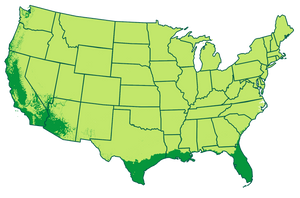* Images shown are of mature plants

Have questions? Talk with our Plant Experts (800) 973-8959
Save 25% on $200+ with code FALL25.
Questions? Call our plant experts: (800) 973-8959
Tasty, Seedless Oranges and Quick Growth
Why Navel Orange Trees?
Healthful and delicious, the Navel Orange is one of the most popular varieties at the grocery store. But you won't believe how much better they are when you grow them yourself: Extremely sweet, these oranges will quickly become an addictive snack. And you'll love them because they're simple to peel and they're seedless.
Plus, these Navel Orange Trees don't require much attention. They'll reward you with plenty of juicy, seedless oranges, effortlessly. Simply plant them wherever you get full sun. Another beneficial aspect of our Navel Oranges is that they have a long shelf life - longer than most other oranges. So, there's no rush to eat, bake or cook them before they go bad. You can store them for months!
Why Fast-Growing-Trees.com is Better
Our Navel Orange Trees have been groomed to perfection, so when you receive your very own, it's ready to produce an abundance of fruit right away. We’ve grafted and greenhouse-grown our varieties, so you get a healthful, well-developed root system and branching once the Navel Orange Tree arrives at your door.
We’ve done the extra work at our nursery so you reap the rewards of easygoing, fast growth – and oranges of your own in just one year.
We expand our crop each year because of high demand. So why wait? Order now to ensure you receive your very own, healthy Navel Orange Tree!
Pollination Info
Navel Orange Tree Pollination
Navel Orange Trees are self-fertile. You will get fruit with only one plant. However, adding an additional Navel Orange Tree will drastically increase the size of your crop.
Planting & Care
1. Planting: Choose a location where your tree is going to get plenty of sunlight, 6 to 8 hours per day is best. Potted plants do enjoy a daily misting for humidity but placing a tray with rocks filled with water under the plant will feed humidity to the tree as the water evaporates.
A planter with built-in casters is a good choice so it can easily be moved. Choose a pot slightly larger than what it was shipped in that has plenty of holes in the bottom to allow for drainage. Be sure to plant in well-draining potting soil, preferably recommended for acid-loving citrus plants.
2. Watering: After watering (generally, about once weekly), allow the top 2 to 3 inches of the soil to dry out completely before watering again. For potted Navel Oranges, stick your index finger into the soil down to about 2 inches.
If there is moisture present, hold off on watering until it feels drier at that depth. When ready to water, stop once you see it escaping the drainage holes at the base of the pot.
3. Fertilizing: Feed your Navel Orange Tree during the warmer spring and summer seasons with a citrus-specific fertilizer, like the one included in our Citrus Care Kit, once every six weeks. During the fall and winter season, ease back to fertilizing once every 2 to 3 months. Make sure to follow the application instructions written on the fertilizer bag.
4. Pruning: Make 45-degree angle cuts to remove dead or crossing limbs and also to thin out the tree to allow more light to flow between the branches. After the tree fruits, remove any dead wood and ventilate the center of the tree. Remove suckers as they form/grow from the base as they will steal away nutrients from the primary trunk of the tree. Pruning can be done at any time of the year for the potted Navel Oranges.
5. Pollination: Our trees are self-fertile, but you can pollinate your indoor trees by hand since most people do not keep a healthy bee population within their home. Simply take a small, dry, fine-tipped paintbrush and stick it into the center of the bloom. Swirl it around and collect the pollen on the brush. Go to the next bloom and repeat the process until every bloom has been treated. Do this once daily and don’t wash the paintbrush until after the blooms have been pollinated. The bloom will fall off naturally and the fruit will begin to form.
FAQs
What is the difference between an orange and a Navel Orange?
How did Navel Oranges originate?
How long does it take a Navel Orange Tree to produce fruit?
How big does a Navel Orange Tree get?
Do Navel Orange Trees need full sun?
Shipping Details
Estimated Shipping Time: Most orders ship immediately. As noted on the website, some items are seasonal, and may only ship in spring or fall. Once your order is shipped, you'll receive an email with a tracking number.
| Amount of Order | Shipping Charge |
|---|---|
| Less than $49 | $19.95 |
| $49 + | FREE SHIPPING! |
Product Details
| Mature Height: | 8 ft. |
| Mature Width: | 8-12 ft. |
| Sunlight: | Full-Partial |
| Growth Rate: | Moderate Growing |
| Botanical Name: | Citrus sinensis 'Washington' |
| Does Not Ship To: | AK, AL, AZ, CA, FL, GA, HI, LA, MS, OR, TX |
| Grows Well In Zones: | 3-11 patio / 9-11 outdoors |
| Your Growing Zone: | # |









